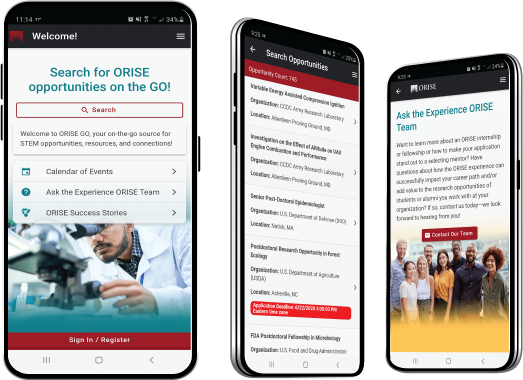EPA Wood Combustion Emission Modeling Research Opportunity
Connect with ORISE...on the GO! Download the new ORISE GO mobile app in the Apple App Store or Google Play Store to help you stay engaged, connected, and informed during your ORISE experience and beyond!
-
An application
-
Transcript(s) – For this opportunity, an unofficial transcript or copy of the student academic records printed by the applicant or by academic advisors from internal institution systems may be submitted. All transcripts must be in English or include an official English translation. Click here for detailed information about acceptable transcripts.
-
A current resume/CV, including academic history, employment history, relevant experiences, and publication list
-
Two educational or professional recommendations. Click here for detailed information about recommendations.
*Applications may be reviewed on a rolling-basis and this posting could close before the deadline. Click here for information about the selection process.
EPA Office/Lab and Location: A research opportunity is available at the Environmental Protection Agency (EPA), Office of Research and Development (ORD), Center for Environmental Measurement and Modeling (CEMM), Atmospheric and Environmental Systems Modeling Division (AESMD) located in Research Triangle Park, North Carolina.
Research Project: Wood combustion introduces massive amounts of organic particles and vapors to the atmosphere. These emissions arise from controlled activities like residential operation of woodstoves, uncontrolled events like wildfires, and semi-controlled practices like prescribed burns of forests, grasslands, and agricultural fields. The magnitude and chemical composition of the emissions from these fires varies depending on several factors like the controls in place, the fire size, the types of fuel being burned, and the coincident meteorology. Once introduced to the atmosphere these compounds, undergo dynamic phase partitioning and ongoing chemistry that determine the chemical properties of the resulting downwind plume and thus influence human exposure and ecosystem impacts of the fire.
In order to understand the evolution of wood-combustion emissions in the atmosphere, quantify its potential impact on public health and design effective control strategies for those emissions that may be controlled, three-dimensional chemical transport models (CTMs) are often used. The Community Multiscale Air Quality (CMAQ) modeling system, developed and maintained by the U.S. Environmental Protection Agency (EPA), is a state-of-the-science CTM widely used in both regulatory and research applications.
This research project will involve upgrades to CMAQv5.3.2 (www.github.com/usepa/cmaq) with new algorithms aimed at representing the gas-particle partitioning and multigenerational aging of wood-combustion emissions. The overall goal is then to evaluate the ability of the new model to capture organic aerosol concentrations observed during a number of recent scenarios including a wildfire event, a prescribed burn episode, and a wintertime season with elevated residential wood burning. Based on these findings, recommendations may then be made to emissions inventory and modeling experts on how best to treat emissions from fires going forward.
- Learning how CMAQ simulates a variety of scenarios, developing skills in designing sensitivity simulations, and gaining experience analyzing the impacts of model developments
- Learning how to analyze laboratory and field experiments focused on wood-combustion processes and develop them into profiles fit for use in emissions modeling databases and software
- Chemical transport modeling of ambient particulate matter, particularly the development and application of CMAQ
- Wood-combustion emissions and atmospheric organic chemistry
- Interpreting lab and field results to inform emissions models and chemical transport models
- Effectively working both independently and within a diverse team of researchers
The research participant will have the opportunity to present their work through a combination of reports and technical presentations. The research conducted may also contribute to a manuscript for submission to a peer-reviewed journal.
Mentor(s): The mentor for this opportunity is Benjamin Murphy (murphy.benjamin@epa.gov). If you have questions about the nature of the research please contact the mentor(s).
Anticipated Appointment Start Date: Fall 2020. All start dates are flexible and vary depending on numerous factors. Click here for detailed information about start dates.
Appointment Length: The appointment will initially be for one year and may be renewed three to four additional years upon EPA recommendation and subject to availability of funding.
Level of Participation: The appointment is full-time.
Participant Stipend: The participant will receive a monthly stipend commensurate with educational level and experience. Click here for detailed information about full-time stipends.
EPA Security Clearance: Completion of a successful background investigation by the Office of Personnel Management (OPM) is required for an applicant to be on-boarded at EPA.
ORISE Information: This program, administered by ORAU through its contract with the U.S. Department of Energy (DOE) to manage the Oak Ridge Institute for Science and Education (ORISE), was established through an interagency agreement between DOE and EPA. Participants do not become employees of EPA, DOE or the program administrator, and there are no employment-related benefits. Proof of health insurance is required for participation in this program. Health insurance can be obtained through ORISE.
Questions: Please see the FAQ section of our website. After reading, if you have additional questions about the application process please email EPArpp@orau.org and include the reference code for this opportunity.
The qualified candidate should be currently pursuing or have received a bachelor's, master's or doctoral degree in one of the relevant fields. Degree must have been received within five years of the appointment start date.
- Experience working with Linux and shell scripting
- Experience programming in Fortran
- Experience analyzing datasets with R, Python, Matlab, or a similar language
- Some knowledge of atmospheric chemistry and physics, especially organic aerosol chemistry and gas-particle partitioning
- Some basic awareness of issues related to estimating fire impacts on air quality
- Citizenship: U.S. Citizen Only
- Degree: Bachelor's Degree, Master's Degree, or Doctoral Degree received within the last 60 months or currently pursuing.
- Discipline(s):
- Veteran Status: Veterans Preference, degree received within the last 120 month(s).

 ORISE GO
ORISE GO

The ORISE GO mobile app helps you stay engaged, connected and informed during your ORISE experience – from application, to offer, through your appointment and even as an ORISE alum!





